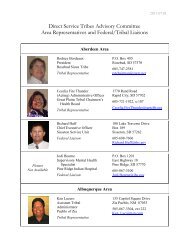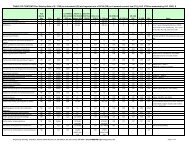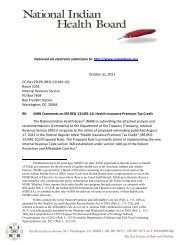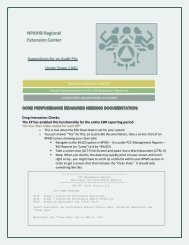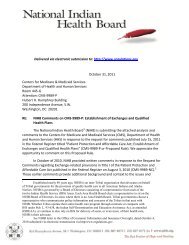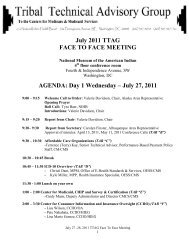mmpc - National Indian Health Board
mmpc - National Indian Health Board
mmpc - National Indian Health Board
You also want an ePaper? Increase the reach of your titles
YUMPU automatically turns print PDFs into web optimized ePapers that Google loves.
Conclusions and Recommendations<br />
proportion of overall payments. Prescription drug payments contributed little to the payments for IHS AIAN<br />
compared to their contribution to payments for Other AIAN or whites. There were almost no payments for IHS<br />
Program claims for prescription drugs outside of the Bemidji Area.<br />
This evidence supports the general conclusion that in most Areas the IHS system providers and the state<br />
Medicaid programs with which they interface in these Areas are as a whole are doing a well at billing and<br />
collection for services provided to Medicaid enrolled users of the IHS system. In Aberdeen, Billings,<br />
Albuquerque and Oklahoma Areas, however, it is possible that either IHS system or other providers who<br />
provide care for these AIAN do not file as many claims, or are denied more claims for their care. It is also<br />
possible that in Albuquerque Area the reason that lower payments were found only compared to self-declared<br />
AIAN who do not use the IHS system is because these other AIAN have higher demands for health care when ill<br />
because they are not in the IHS system. The morbidity risk-adjustment is only a partial adjustment for health<br />
status differences, because it depends on people accessing their Medicaid health care provider over the year to<br />
have information on health status to adjust.<br />
Medicaid-enrolled IHS Active Users without IHS Program Medicaid claims<br />
IHS Active Users with Medicaid claims but no IHS Program Medicaid claims had substantially lower payments<br />
over all the recipient types analyzed. The per capita payments for this subgroup of IHS AIAN were substantially<br />
lower for all types of Medicaid recipients analyzed than those of: 1) other IHS AIAN with IHS Program Medicaid<br />
claims, 2) other AIAN who did not use the IHS system, and 3) whites living in the same counties. This was found<br />
as an overall conclusion for all IHS Areas when the compared to the IHS AIAN with IHS Program Medicaid<br />
claims. This was found for all but one IHS Area compared to other AIAN (Nashville) and for one IHS Area<br />
compared to whites (Tucson). The payments were risk-adjusted and therefore it is not likely that they are<br />
lower because these are healthier IHS AIAN than the other groups of IHS AIAN. This finding supports the<br />
conclusion that IHS system providers may not be doing all the billing and collections of Medicaid for care they<br />
have provided to their IHS user population.<br />
Medicaid-paid Fraction of IHS Active User Costs<br />
The fraction of health care costs needed by the IHS Active User population that is paid by Medicaid (and<br />
Medicaid-CHIP) is 25% or more in 9 of 12 IHS Areas, but varied from 19% to 65% depending on the IHS Area.<br />
Areas with the lowest fraction of about one-fifth are Nashville (19%) and Oklahoma (21%). Aberdeen,<br />
California, Albuquerque, Portland and Bemidji Areas have mid-range fractions of between a little more than one<br />
quarter and a little less than one-third (27% to 31%). Alaska and Billings are in the middle of the Area rankings<br />
with a little more than one-third of the costs paid by Medicaid (34% to 38%). And Navajo and Phoenix have<br />
Medicaid fractions of nearly one half (46% and 49% respectively). Tucson has the highest Medicaid paid<br />
fraction of nearly two-thirds (65%).<br />
When the amounts paid by Medicaid to IHS and tribal providers are separated out of the Medicaid fraction and<br />
compared to the total health care costs of their user population, the Areas with the lowest reported Medicaid<br />
fraction paid to IHS and tribal providers by Medicaid are Nashville (2%), Bemidji (4%), Oklahoma (4%) and<br />
California (6%). For Portland, Albuquerque, and Aberdeen Areas only 8% the total health care costs needed by<br />
their user population are paid to IHS and tribal providers by Medicaid, and in Alaska Area it is only 9%. Billings<br />
(12%), Navajo (19%), Phoenix (21%), and Tucson Areas (24%) receive the highest Medicaid fractions.<br />
42




